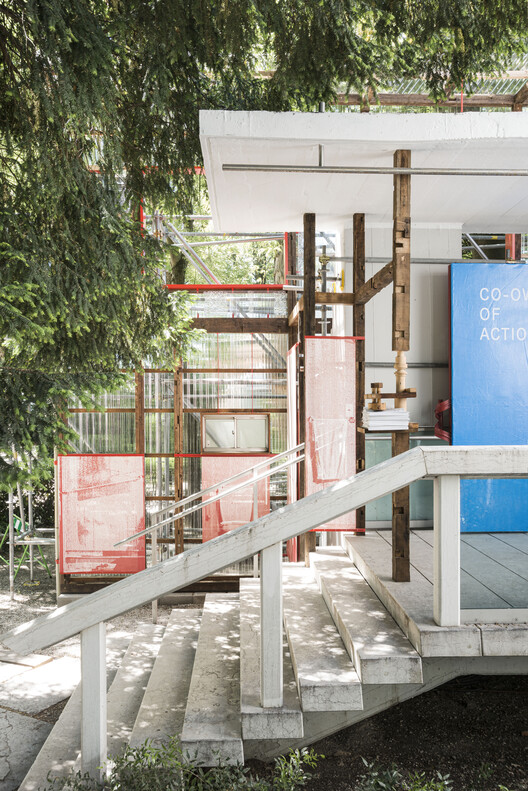
The 17th Venice Architecture Biennale is currently unfolding, revealing a wide range of answers to the question "How will we live together". With 60 national pavilions, numerous contributions of invited architects from all around the world and several collateral events, this year's edition restates the Biennale's role as a platform for inquiry, exploration, and disruptive thinking in architecture. Curator Hashim Sarkis' original statement called upon architects "to imagine spaces in which we can generously live together." Recent circumstances have made the question even more relevant, prompting a holistic re-evaluation of how the world as a collective can face changes and challenges of an unprecedented scale from the disrupting role of technology, to inequality, mass migration and climate change. The following national contributions reflect on "how will we live together" amidst climate change, exploring ideas for a more sustainable future.
As this year's Biennale theme was an invitation to question the status quo and reflect on the future, it has brought society's relationship with the environment into sharper focus. With the construction sector responsible for a staggering 39% of global greenhouse gases, architects have a significant role in addressing climate change. Moreover, the extents and implications of this issue have been made even more apparent during the pandemic, as the same activities that contribute to climate change enable the emergence of new diseases. In this sense, several national pavilions have chosen to frame Sarkis' question through the lens of sustainability and climate change, exploring either its consequences on communities and the built environment or investigating possible actions that could help society move forward sustainably.
Italy: Resilient Communities

The exhibition curated by Alessandro Melis approaches the issue of climate change through urban resiliency, exploring local means of adapting to changing environmental conditions and investigating scenarios for the future. The pavilion presents Italian research and innovation across different fields, exploring ideas for improving the conditions of the built environment and addressing climate change, with the hope of defining the building blocks for a sustainable future. The curatorial project is shaped as an interdisciplinary research laboratory investigating how architecture can respond to environmental issues and foster resiliency.
UAE: Wetland

Addressing the environmental impact of the construction industry, the UAE Pavilion curated by Wael Al Awar and Kenichi Teramoto presents an alternative to traditional cement, the manufacturing of which is one of the largest sources of CO2 emissions. The exhibition showcases an innovative, environmentally friendly cement made of recycled waste brine, a byproduct of industrial desalination. The project explores a hyper-local, experimental solution for mitigating carbon emissions within the construction sector, using a resource-abundant in UAE and countries with similar environments. The locally sourced material can be moulded in standard bricks and presents the necessary strength and durability to be a viable solution in reducing carbon emissions.
Turkey: Architecture as Measure

Turkey's contribution to the Biennale reframes climate emergency through the interplay between the mundane, everyday life and the planetary scale, highlighting architecture's agency in addressing the issue. In the context of the current climate crisis, the curatorial project of Neyran Turan challenges a radical revaluation of society's relationship with the planet and calls for a re-imagining of the environment altogether in order to build an alternative future. The focus on imagination stems from the urgency of climate change that calls for unconventional approaches to produce meaningful structural changes. The pavilion explores the politics and logistics of architectural construction while also showcasing environmental controversies in a series of selected sites in Turkey.
Japan: Co-ownership of Action: Trajectories of Elements

The Japanese Pavilion, curated by Kadowaki Kozo, invites visitors to reflect on the movement of goods fuelling mass consumption and rethink sustainability and reuse in architecture. By dismantling an old wooden Japanese house and transporting it to Venice to be reconstructed in a new configuration, the exhibition exemplifies how old materials could be given an entirely new existence by putting the current movement of goods in the service of reuse rather than consumption. The curatorial project brings into focus the architectural possibilities of material recycling, creating a conversation around the urgency of resource conservation.
The Netherlands: Who is We?

Taking climate change mitigation to the city level, the Pavilion of the Netherlands, curated by Francien van Westrenen argues for a more inclusive design and a more environment-oriented approach in architecture and urban planning. Among the projects showcased, Multispecies Urbanism, authored by Debra Solomon, proposes an inter-species urban development and presents tools for creating environmentally democratic urban landscapes. The exhibition and the accompanying Values for Survival research program aim to inspire cities to take action in what is thought as "the decisive decade of climate change".
We invite you to check out ArchDaily's comprehensive coverage of the Venice Architecture Biennale 2021, and watch our official playlist on Youtube featuring exclusive interviews with architects and curators of the Biennale.

















































